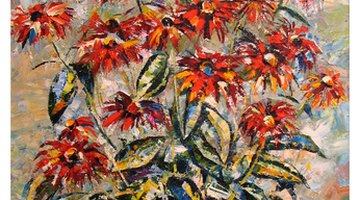Whether an old family heirloom or something picked up at a garage sale, cleaning an oil painting is delicate work. Oil paintings often gather dust which then mixes with the varnish that is meant to protect the oil paint. To clean the painting, the varnish must be removed with denatured alcohol, which could dry out and harm the oil paint under the varnish. Using turpentine and linseed oil saves the paint and the painting.
- Whether an old family heirloom or something picked up at a garage sale, cleaning an oil painting is delicate work.
- To clean the painting, the varnish must be removed with denatured alcohol, which could dry out and harm the oil paint under the varnish.

Apply denatured alcohol to a cotton wool pad until the pad is moist.
Moisten a clean cotton wool pad with five parts turpentine and one part linseed oil.
Rub the oil painting in a gentle, circular motion with the alcohol-soaked cotton ball. This will reduce the varnish to a gummy substance that will stick to the cotton wool pads or remain on the painting. If it remains on the painting, it is easily scraped off with a fingernail--but never use a metal utensil as that will scratch the paint.
Remove the varnish from the painting carefully with the alcohol-soaked pad. Watch for spots where the oil paint seems to dry due to the effects of the alcohol. Instantly rub these spots with the turpentine and linseed oil. Gently rub the spot in a circular pattern until the entire area is covered.
Allow this area to dry for an appropriate time, usually an hour, before removing the rest of the varnish. Repeat this process until the entire painting is free of varnish.
WARNING
Sometimes, a painting has been varnished to cover a mistake in the last cleaning. A section of the painting might begin to rub off when cleaning with denatured alcohol. If this happens, be sure to immediately and gently swab the area with the turpentine mixed cotton wool pad to stop any damage and to solidify the paint.
